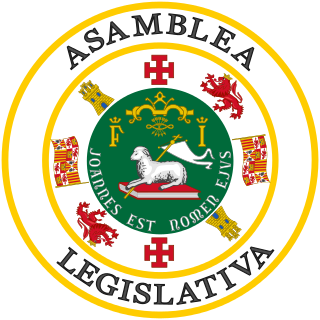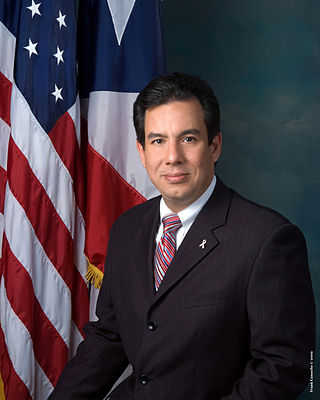
The 82nd United States Congress was a meeting of the legislative branch of the United States federal government, composed of the United States Senate and the United States House of Representatives. It met in Washington, D.C., from January 3, 1951, to January 3, 1953, during the last two years of President Harry S. Truman's second term in office.

The Michigan Senate is the upper house of the Michigan Legislature. Along with the Michigan House of Representatives, it composes the state legislature, which has powers, roles and duties defined by Article IV of the Michigan Constitution, adopted in 1963. The primary purpose of the Legislature is to enact new laws and amend or repeal existing laws.

The Georgia state Senate is the upper house of the Georgia General Assembly, in the U.S. state of Georgia.

The House of Representatives of Puerto Rico is the lower house of the Legislative Assembly of Puerto Rico, the bicameral territorial legislature of Puerto Rico. The House, together with the Senate, control the legislative branch of the government of Puerto Rico.

The Legislative Assembly of Puerto Rico is the territorial legislature of the Commonwealth of Puerto Rico, responsible for the legislative branch of the government of Puerto Rico. The Assembly is a bicameral legislature consisting of an upper house, the Senate normally composed of 27 senators, and the lower house, the House of Representatives normally consisting of 51 representatives. Eleven members of each house are elected at-large rather than from a specific legislative district with all members being elected for a four-year term without term limits.

Thomas Rivera Schatz is a Puerto Rican politician, legal advisor, attorney, and former prosecutor, who was the fourteenth and sixteenth President of the Senate of Puerto Rico. He is affiliated with New Progressive Party of Puerto Rico and the mainland Republican Party. On July 22, 2019, Rivera Schatz announced that he will take over as acting chair of the PNP following the resignation of Ricardo Rosselló due to the Telegramgate scandal.

Elections in Puerto Rico are guaranteed by Article Six of the Constitution of Puerto Rico and the Electoral Code of Puerto Rico for the 21st Century Act. All processes are overseen and managed in whole by the Puerto Rico State Elections Commission; an autonomous agency of the executive branch of the government of Puerto Rico.

The Connecticut State Senate is the upper house of the Connecticut General Assembly, the state legislature of the U.S. state of Connecticut. The state senate comprises 36 members, each representing a district with around 99,280 inhabitants. Senators are elected to two-year terms without term limits. The Connecticut State Senate is one of 14 state legislative upper houses whose members serve two-year terms; four-year terms are more common.

The Alabama State Senate is the upper house of the Alabama Legislature, the state legislature of the U.S. state of Alabama. The body is composed of 35 members representing an equal number of districts across the state, with each district containing at least 127,140 citizens. Similar to the lower house, the Alabama House of Representatives, the senate serves both without term limits and with a four-year term.

The Legislature of the State of Oklahoma is the state legislative branch of the U.S. state of Oklahoma. The Oklahoma House of Representatives and Oklahoma Senate are the two houses that make up the bicameral state legislature. There are 101 state representatives, each serving a two-year term, and 48 state senators, who serve four-year terms that are staggered so only half of the Oklahoma Senate districts are eligible in each election cycle. Legislators are elected directly by the people from single member districts of equal population. The Oklahoma Legislature meets annually in the Oklahoma State Capitol in Oklahoma City.

The Oklahoma Senate is the upper house of the two houses of the Legislature of Oklahoma, the other being the Oklahoma House of Representatives. The total number of senators is set at 48 by the Oklahoma Constitution.

Manuel A. Torres-Nieves, Puerto Rico's longest-serving secretary of the Senate of Puerto Rico in modern times, first served during the tumultuous years of 2005–2008 in which the Senate was controlled by the pro-statehood New Progressive Party (NPP) while the governorship had been controlled by the pro-status quo Popular Democratic Party, served a second consecutive term as Senate Secretary after having served as Acting President of the Senate from January 1–12, 2009, between the Senate presidencies of Kenneth McClintock and Thomas Rivera Schatz. He then served as Puerto Rico's first Electoral Comptroller before his third election as secretary of the Senate during Rivera Schatz' historic second non-consecutive term as Senate President, which ended January 11, 2021. On March 11, 2021, Governor Pedro Pierluisi nominated him as Comptroller of Puerto Rico, a constitutional role which requires the advice and consent of both the Senate and the House of Representatives.
José Granados Navedo, is a former Speaker Pro Tem of the House of Representatives of Puerto Rico. Married, with three children, he lives with his family in Florida.

José Luis Dalmau Santiago is an attorney and politician. He is the current President of the Senate of Puerto Rico. In February of 2023, he announced that he was evaluating the possibility of a PDP candidacy for governor of Puerto Rico in the 2024 elections.

Antonio "Tony" J. Fas Alzamora is a Puerto Rican politician and Senator. As of 31 December 2011, he was the longest-serving legislator in the history of Puerto Rico, having served in ten Legislative Assemblies, one House of Representatives, and nine Senates.

The president of the Senate of Puerto Rico is the highest-ranking officer and the presiding officer of the Senate of Puerto Rico. The president has voting powers as it is elected amongst the own members of the Senate as established by Article III of the Constitution of Puerto Rico. The Constitution, however, does not establish its functions and since the Senate is the only body authorized by the Constitution to regulate its own internal affairs, the functions of the president vary from session to session—save being called "President" as the Constitution establishes. The president is typically elected during the Senate's inaugural session.

General elections were held in Puerto Rico on Tuesday, November 6, 2012, to elect the officials of the Puerto Rican government that would serve for the next four years, most notably the Governor of Puerto Rico. A status referendum was held on the same date.

The Senate of Puerto Rico majority and minority leaders are Puerto Rican Senators who are elected by the party conferences that hold the majority and the minorities respectively. These leaders serve as the chief Senate spokespeople for their parties and manage and schedule the legislative and executive business of the Senate. By rule, the Presiding Officer gives the Majority Leader priority in obtaining recognition to speak on the floor of the Senate. The Majority Leader customarily serves as the chief representative of his or her party in Senate.
The 2012 Puerto Rico Senate election was held on November 6, 2012, to elect the members of the Senate of Puerto Rico for the next four years, from January 2, 2013 until January 1, 2017.

The 2020 Puerto Rico Senate election was held on November 3, 2020, to elect the members of the 27th Senate of Puerto Rico, concurrently with the election of the Governor, the Resident Commissioner, the House of Representatives, and the mayors of the 78 municipalities. The winners will be elected to a four-year term from January 2, 2021, to January 2, 2025.

















